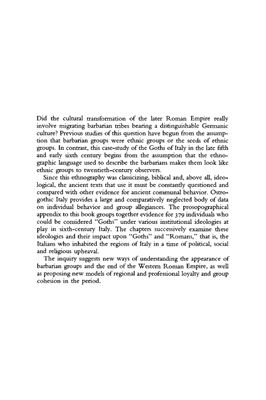Cambridge: Cambridge University Press, 1997. – 547 p. – (Cambridge
Studies in Medieval Life and Thought).
ISBN 0 521 57151-0 (he)
The barbarians of the fifth and sixth centuries were long thought to be races, tribes or ethnic groups who toppled the Roman Empire. This book proposes a new view, through a case study of the Goths of Italy between 489 and
554. The author suggests wholly new ways of understanding barbarian groups and the end of the Weste Roman Empire. The book also proposes a complete reinterpretation of the evolution of Christian conceptions of community, and of so-called "Germanic" Arianism.
CONTENTS
Preface
List of rulers
Terminology and vocabulary
List of abbreviations
Map of Ostrogothic Italy
Introduction: Studying the barbarians in late antiquity
- Ethnicity, ethnography and community in the fifth and sixth centuries
- The Ravenna govement and ethnographic ideology: from civilitas to bellicositas
- Individual reactions to ideology I: names, language and profession
- Complementary and competing ideals of community: Italy and the Roman Empire
- Individual reactions to ideology II: soldiers, civilians and political allegiance
- Catholic communities and Christian Empire
- Individual reactions to ideology III: Catholics and Arians
- The origin of the Goths and Balkan military culture
Conclusion
- Appendix 1: The inquiry into Gundila's property: a translation and chronology
- Appendix 2: The Germanic culture construct
- Appendix 3: Archeological and toponymic research on Ostrogothic Italy
- Appendix 4: Dress, hairstyle and military customs
- Prosopographical Appendix: A prosopography of Goths in Italy, 489–554
- Bibliography
- Index
ISBN 0 521 57151-0 (he)
The barbarians of the fifth and sixth centuries were long thought to be races, tribes or ethnic groups who toppled the Roman Empire. This book proposes a new view, through a case study of the Goths of Italy between 489 and
554. The author suggests wholly new ways of understanding barbarian groups and the end of the Weste Roman Empire. The book also proposes a complete reinterpretation of the evolution of Christian conceptions of community, and of so-called "Germanic" Arianism.
CONTENTS
Preface
List of rulers
Terminology and vocabulary
List of abbreviations
Map of Ostrogothic Italy
Introduction: Studying the barbarians in late antiquity
- Ethnicity, ethnography and community in the fifth and sixth centuries
- The Ravenna govement and ethnographic ideology: from civilitas to bellicositas
- Individual reactions to ideology I: names, language and profession
- Complementary and competing ideals of community: Italy and the Roman Empire
- Individual reactions to ideology II: soldiers, civilians and political allegiance
- Catholic communities and Christian Empire
- Individual reactions to ideology III: Catholics and Arians
- The origin of the Goths and Balkan military culture
Conclusion
- Appendix 1: The inquiry into Gundila's property: a translation and chronology
- Appendix 2: The Germanic culture construct
- Appendix 3: Archeological and toponymic research on Ostrogothic Italy
- Appendix 4: Dress, hairstyle and military customs
- Prosopographical Appendix: A prosopography of Goths in Italy, 489–554
- Bibliography
- Index

